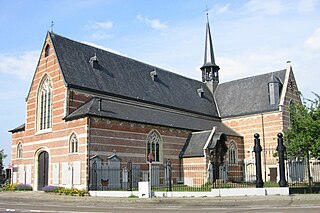
Soignies is a municipality of Wallonia located in the province of Hainaut, Belgium.

Sigebert III was the Merovingian king of Austrasia from 633 to his death around 656. He was described as the first Merovingian roi fainéant —do-nothing king—, in effect the mayor of the palace ruling the kingdom throughout his reign. However he lived a pious Christian life and was later sanctified, being remembered as Saint Sigebert of Austrasia in the Roman Catholic Church and Eastern Orthodox Church.

Sep. 19 - Eastern Orthodox liturgical calendar - Sep. 21

April 8 - Eastern Orthodox liturgical calendar - April 10

April 16 - Eastern Orthodox liturgical calendar - April 18

Ghislain was a confessor and anchorite in Belgium. He died at the town named after him, Saint-Ghislain.

Philibert of Jumièges was an abbot and monastic founder, particularly associated with Jumièges Abbey.

Saint Waltrude is the patron saint of Mons, Belgium, where she is known in French as Sainte Waudru, and of Herentals, Belgium, where she is known in Dutch as Sint-Waldetrudis or -Waltrudis. Both cities boast a large medieval church that bears her name.
Hidulf was an abbot, founder of Moyenmoutier Abbey, and reputed bishop of Trier. He is a Catholic and Orthodox saint. His feast day is 11 July.

Saint Poppo was a knight of noble descent who turned to a monastic life after experiencing a spiritual conversion. He became one of the best known abbots of Stavelot and was one of the first recorded Flemish pilgrims to the Holy Land. Liturgically, he is commemorated on 25 January.

Aldetrude was a Christian saint and from 684 was abbess of Maubeuge Abbey in the County of Hainault, now in northern France. She is also known as Aldetrude de Maubeuge, Aldetrude of Maubod, Aldetrudis and Adeltrude.

Saint Fredigand of Deurne was an 8th-century Irish missionary in the territory around Antwerp in what is now Belgium. His feast day is 17 July.

Saint Geremarus was a Frankish monk and abbot. His feast day is 24 September.
Saint Wasnulf was a Scottish missionary in what is now Belgium. His feast day is 1 October.
Alberic of the Ardennes, Alberick, or Albéric l'Orphelin de Hainaut d'Ardenne, also called the Orphan, was a Frankish nobleman and Merovingian Count of Hainaut.
Saint Bertille of Thuringia(French: Sainte Bertille de Thuringe or also known as Saint Bertilla, the daughter of Bercarius, King of Thuringia, was a Frankish saint who resided in the County of Hainaut in Belgium. Bertille was the mother of Saint Waltrude and Aldegonde, foundress of Maubeuge Abbey.

Landry, Landric, Landericus, or Landry of Soignies, commonly known as Saint Landry of Metz was a Roman Catholic Bishop of Metz, Benedictine abbot of Haumont and Soignies, and a Frankish saint. He was the son of Saint Waltrude and Madelgaire.

Dentelin, Dentelinus, or Saint Dentelin of Soignies was a Frankish saint. He was the son of Saint Waltrude and Madelgaire.

Aubert of Cambrai or Aubertus was a Merovingian Bishop of Cambrai and Arras and a Frankish saint.

Collegiate Church of Saint-Vincent de Soignies or Saint-Vincent Collegiate Church of Soignies is a church located in Soignies, Hainaut Province in Belgium.














